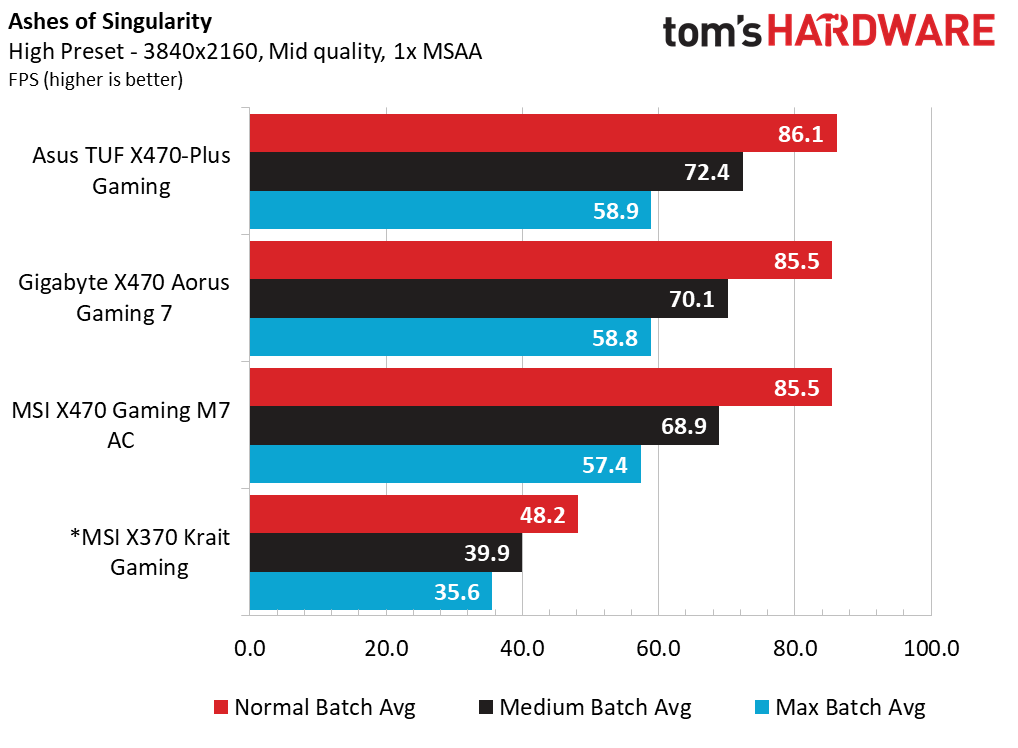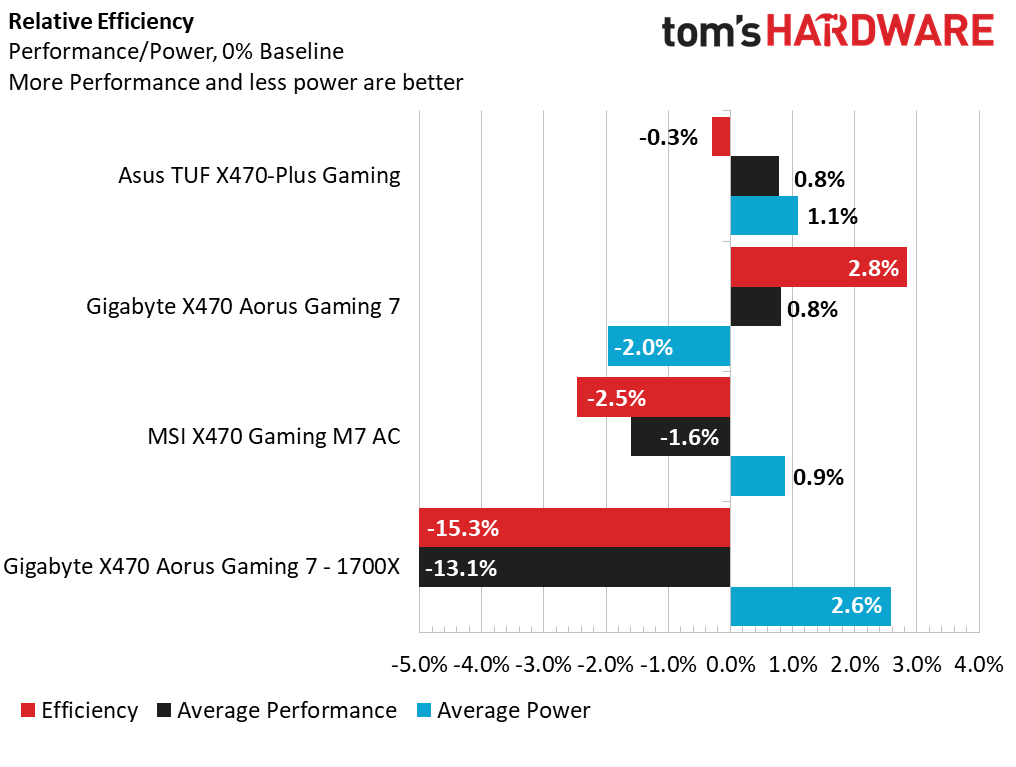Asus TUF X470-Plus Gaming Review: Attractive Value
Why you can trust Tom's Hardware
Test Results: Games, Performance & Power




At lower resolutions in 3DMark, we saw the Asus TUF X470-Plus Gaming suffer a bit. Let’s see if this translates to real gaming scenarios. We'll start with The Talos Principle. FHD presets a modest loss for the TUF at both resolution presets. Bumping up the resolution to 4k helps shift some of the burden off the processor and on to the GPU, but not by much. The TUF still winds up roughly 2 percentage points behind at Medium and half a percent at Ultra.


F1 2015 continues to favor the Gigabyte X470 Aorus Gaming 7, but the Asus only trails by the slightest of margins here. On the bright side, the MSI X470 continues to hang close to the Asus board for the most part, only showing a real slump at 4k at Ultra settings.




Analyzing the black bars in our charts, which represents average framerates, we see similar results to F1 2015. The Gigabyte board leads the way at 1080p and 4k at both detail settings. Still, with only a few percentage points separating the higher settings, each platform is equally playable on high refresh rate monitors.




Finally a game the Asus board starts to excel at, even if it’s only by 0.6fps! Ashes of the Singularity Escalation’s GPU benchmark still hammers all of our Ryzen cores enough to tax even at 1080. In an interesting turn of events, the MSI X470 Gaming M7 AC wins at 4K and the Crazy setting. Overall, this is another situation where each of the X470 boards performs adequately for our purposes today.
With a strong win in Applications and average performance in Gaming and Synthetics, the Asus TUF X470-Plus Gaming manages to tie the Gigabyte Aorus board in overall performance. The MSI board, however, trails by up to 1.8 percentage points against the average in most metrics, but still performs well above the old Ryzen 1700X bench--as it should. With performance out of the way, let’s look at some of the features that will really prove this value board’s worth.
Power, Thermals & Efficiency
From a total system power perspective, this system delivers. At idle, our system is drawing an impressive 48W from the wall, which made us doublecheck our measurements and previous systems’ data. Kicking off Prime95, Small FFTs actually observe higher system power usage by a considerable margin. FurkMark lets the CPU take a slight break, with the MSI taking a heavy hit burning 12W more power than the TUF contender. However, full system load hits the TUF system hard and we see 425W total system power draw from the socket. For the given target audience, the Asus X470 TUF-Plus Gaming power draw is respectable and will work well for power usage during gaming.
From a temperature perspective, this board's processor installation works just as well as other motherboard samples under full Prime95 load. However, the Vregs are toasty at an impressive 69C above ambient. Fortunately for Asus, that's within the safe zone for these regulators. Even under AIDA64, we’re seeing regulator temperatures that are a little too high for our taste. For a system not even overclocked, it would have been nice to see regulators that had a little more surface area for cooling.
Get Tom's Hardware's best news and in-depth reviews, straight to your inbox.
Just as we saw in our initial X470 launch coverage, the Gigabyte X470 Aorus Gaming 7 performs well in terms of efficiency, thanks to its lower idle power and total system usage. The Asus TUF X470-Plus Gaming just barely dips in the red for efficiency, due to higher overall system power usage. This might be tunable in the UEFI though, if efficiency is a concern. And for comparison purposes, we leave the 1700X data in the chart. Clearly the newer boards with the new processor are more efficient.
MORE: Best Motherboards
MORE: How To Choose A Motherboard
MORE: All Motherboard Content
Current page: Test Results: Games, Performance & Power
Prev Page Test Configuration & Benchmark Results Next Page Overclocking & Verdict-
Soda-88 So you're telling me that a motherboard with far more inefficient VRM due to lack of phases (31W higher consumption than Gaming 7 in Prime/Furmark) is a good overclocking board? Have you measured the VRM temperatures at all?Reply
This motherboard is a ticking timebomb if you plan on running 8 core CPU at high utilization.
Another thing regarding this motherboard in particular is that it shares the same VRM design with $75 ASUS motherboards (with addition of better capacitors, which in no way redeems the inadequacy of VRM in general).
Prime X470 Pro VRM is quite significantly better (it's the same VRM as on Strix SKUs) and it comes at nearly the same price.
For more info watch this:
https://www.youtube.com/watch?v=pq0MLtjFS1A -
Calculatron I'm not sure how I feel about the TUF brand being re-purposed like this. I'm sure that it made sense to ASUS to use an existing, and popular, type of branding to cover a market segment. The marketing and accounting departments probably thought it was a win, and no doubt profits will reflect that. Let us hope that, in the future, there is room to create a class of no-nonsense overclocking boards.Reply -
TheTerk Reply
I don't know if you're trolling me, but I clearly state this in the overclocking section....21177573 said:So you're telling me that a motherboard with far more inefficient VRM due to lack of phases (31W higher consumption than Gaming 7 in Prime/Furmark) is a good overclocking board? Have you measured the VRM temperatures at all?
This motherboard is a ticking timebomb if you plan on running 8 core CPU at high utilization.
Another thing regarding this motherboard in particular is that it shares the same VRM design with $75 ASUS motherboards (with addition of better capacitors, which in no way redeems the inadequacy of VRM in general).
Prime X470 Pro VRM is quite significantly better (it's the same VRM as on Strix SKUs) and it comes at nearly the same price.
For more info watch this:
https://www.youtube.com/watch?v=pq0MLtjFS1A
At these settings our Vreg heatsinks were starting to reach 131 C, so you'll want to pick a board with higher phase counts and bigger heatsinks for prolonged overclocks.
-
Anheanz I purchased this mobo from my local Microcenter and it was DOA. It was promptly replaced with a Gigabyte x470 gaming 5Reply -
jpe1701 It seems like the vrms on the AMD boards are worse than Intel. At least the mid range and down anyways. I have the x370 taichi and the quality is fantastic though, the only thing lacking is the new agesa code bios update hasn't been released yet. All the other Asrock am4 motherboards have it.Reply



